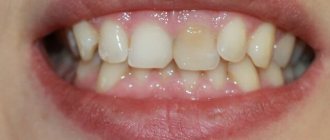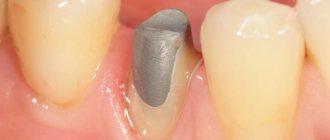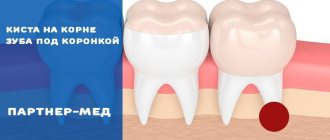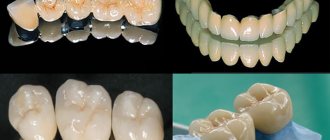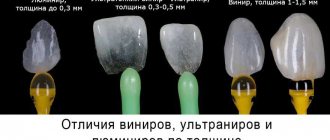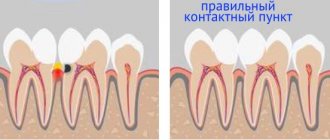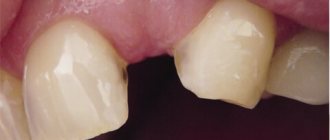When is a crown needed?
Prosthetics with a crown is suitable for the following cases:
- untreated caries, due to which most of the tooth has collapsed;
- injuries: chipped pieces of enamel, deep cracks;
- darkening or yellowing of the enamel that spoils the smile.
The dentist offers the patient a choice between a crown and a filling only if both methods are suitable. If the doctor sees that filling a damaged tooth is pointless, he immediately suggests installing a crown.
When half of a tooth is destroyed, dentists recommend installing a veneer. If more than half has fallen apart, it is usually recommended to install a crown.
Before fixing the crown, the doctor drills out the tissue destroyed by caries so that the microbes no longer “eat” the tissue.
Differences
Typically, crowns are much stronger than fillings. The only exceptions are structures made of plastic.
If the filling material falls out, the tooth will require repeated treatment, which cannot be said in the case of an installed crown, which can be reinstalled at any time in the absence of external damage.
Fixing crowns takes much longer than the filling process.
Crowns allow you to ideally restore the lost shape of a tooth, while using a filling it is not always possible to achieve this result.
Advantages of a crown over a filling
You can often hear the opinion that before installing a crown, a good part of the tooth is ground down, and because of this, it quickly falls apart. This is wrong. A crown or veneer extends the life of a damaged row unit to 10-15 years. A large filling will have to be replaced after 3-4 years.
A crown is also better than a filling for the following reasons:
- the prosthesis is the same in color and shape as the natural tooth;
- a carefully made crown fits tightly to the enamel;
- dentures look more aesthetically pleasing than fillings.
A high-quality crown protects the tooth from further destruction. The filling has to be drilled out along with healthy tissue, which weakens the tooth.
Restoring part of a “dead” tooth with a filling
Before the restoration begins, endodontic treatment (canal treatment of the tooth) is carried out.
If the “nerve” was removed previously, the dentist will check the quality of the root canal treatment and, if necessary, perform re-treatment. We talk about the complexity of endodontic treatment in the article Why it is impossible to give a 100% guarantee for tooth root canal treatment.
If less than 50% of the crown part of the tooth is destroyed, the lost part can be qualitatively restored using composite filling materials.
Modern filling materials allow the dentist to accurately select the color and transparency of the part of the tooth being restored, to recreate the surface structure and anatomical shape, ensuring the correct bite and contact points with neighboring teeth.
Restoring a tooth with a filling requires the dentist to have a good knowledge of dental anatomy and the skill of a sculptor.
The filling will last 5–7 years
What affects the service life of a filling, when and why it will require replacement, you will learn from the article “Why change an old filling if everything is fine and the tooth is not bothering you?”
Advantages of extension with filling material
The tooth is built up with photopolymer material if caries has “eaten” less than 1/3 of the tissue. A small extended piece looks aesthetically pleasing and does not catch the eye.
Filling a large defect is also acceptable, but after 3-4 years the filling will have to be changed because it does not strengthen the crown of the tooth. If the cavity is large and a filling is placed in the tooth, it may crack and have to be pulled out. Therefore, a crown is a winning option in 4 out of 5 cases.
Can a tooth crown be inexpensive?
The cost of a dental crown per tooth will directly depend on the type of material used, the method of its manufacture, the category of the clinic and its location, as well as the qualifications of the orthopedic doctor. For example, in Moscow, prices for metal crowns can vary from 3,000 to 16,000 rubles, for metal-ceramic crowns - from 7,000 to 40,000 rubles, and the average cost of a ceramic crown is about 21,000 rubles. You can find out in more detail how much a particular dental crown will cost for one tooth during an in-person consultation at a dental clinic.
Restoration of dental crowns
Dentures, like natural teeth, require care - careful oral hygiene and restoration of dental crowns. Service life and repair requirements depend on the material. Structures made of ceramics and metal-ceramics are susceptible to the formation of defects. Zirconium dioxide is more durable and cannot be broken or scratched. A zirconium prosthesis lasts about twenty years and does not require repair. As a rule, indications for restoration of the tooth crown are chips, cracks and discoloration of the structure. The procedure should only be carried out by a specialist; experiments at home often lead to breakage of the prosthesis or damage to healthy teeth.
Stages of the procedure for installing a crown
The crown installation procedure is usually carried out in two stages.
Each stage is carried out separately, and the patient visits the dentist twice to install the crown.
The first stage includes: 1) preparing (grinding) the tooth, 2) taking an impression of the tooth, and 3) installing a temporary crown. The duration of the procedure is from 30 minutes to one hour.
Between the patient's two visits to the dentist, the crown is made in the laboratory of the adult dentistry clinic. This process usually takes about two weeks.
In the second stage, the dentist places the finished crown on the tooth, using filling material to secure it. The procedure takes about 20 minutes.
One-stage crown installation .
A variation of the main method is to install a crown in one step. If the dentist has all the necessary equipment at his disposal, the procedure will take an hour or two.
The first stage of crown installation
Preparing your teeth
Before the crown procedure begins, the dentist anesthetizes both the tooth and the surrounding gum area.
If the root of the dental canal is sealed, dental anesthesia is not needed. However, the dentist may consider it necessary to anesthetize the gums.
Preparation (grinding) of the tooth.
The tooth must be ground on all sides to reduce its size, since crowns must have a certain minimum thickness to ensure sufficient strength. Most crowns are about two millimeters thick. If the crown is porcelain, then the thickness of the porcelain layer should be sufficient to create visible natural translucency.
Additional reduction in tooth size.
During the process of grinding a tooth, the dentist is obliged to remove all damage from it, including poorly installed, “wobbly” or poor-quality fillings. As a result, most of the tooth may be removed. (There is no need to worry about this. The crown will be thicker in such areas).
The closer the tooth is in contact with the inside of the crown (the greater the correspondence between the contacting surfaces), the more firmly the crown will hold.
The prepared tooth must have a certain shape.
The dentist not only reduces the size of the tooth, he gives it the desired shape. The tooth must have a cone shape with a slight bevel angle so that a crown (a hard, inflexible shell) can be placed on it.
The correct shape of the ground tooth should ensure a tight fit and good fixation of the crown.
For a quality installation, it is not enough to simply place the crown on the filling material. The shape of the tooth is of great importance in ensuring a tight fit and reliable fixation of the crown.
The closer the shape of the ground tooth matches the shape of the inside of the crown, the better the crown will hold.
In cases where a large portion of the tooth is missing or significantly damaged, the dentist “builds on” the tooth with filling material (enlarges it) before filing the crown.
After grinding the tooth, the dentist must make an impression of it by applying impression material.
Most dentists use a special paste or powdered substance as an impression mass that has the properties of an impression mass.
It is also necessary to take impressions of the teeth located opposite the ground tooth (that is, the teeth that will come into contact with the crown when chewing). A bite impression is also taken to determine at what angle the patient's teeth meet.
How is the impression used?
The finished impression is sent to a dental laboratory, where a plaster copy is made of it to make a crown.
A plaster copy is an exact reproduction of the crowned tooth and adjacent teeth. Therefore, if the crown is made according to the dimensions of the copy, it will fit exactly on the tooth. In some cases, minor adjustments are still required.
Depending on the individual characteristics of the tooth, the work on making a crown in the laboratory takes about two weeks.
In addition to the procedure:
Some dentists have state-of-the-art milling machines that can be used to design and fabricate a crown right in the office.
Installation of a temporary crown
If the crown is made in a laboratory, you will have to wait about two weeks. At this time, you can install a temporary crown.
A temporary crown will protect your teeth and prevent them from moving.
A temporary crown is usually made of plastic, sometimes a metal-ceramic crown is available. Sometimes, for this purpose, blanks are taken and adjusted to a specific tooth, or they are made according to the dentist’s sketch.
The temporary crown is secured with a filling compound, which is easily removed before installing the permanent crown.
Choice of crown color.
If your new crown has a porcelain surface, your dentist will need to determine what shade of porcelain matches the color of the teeth adjacent to the crown.
The dentist uses a set of small samples in the form of teeth of different shades. This set of samples is called a “shade palette.”
Individual samples are applied in turn to the place where the crown will be installed, and the most suitable one is selected.
Crown installation stage.
Once the crown is made, the dentist can begin installing it.
- Removing the temporary crown
At this stage it is necessary:
Give anesthesia. This stage is not always necessary. Often the process of installing and securing the crown is painless for the patient.
Remove the temporary crown and remove any remaining filling material from the tooth.
- Assessing suitability and appearance of the crown.
Before placing a crown, the dentist must ensure that it is suitable and in good appearance. The assessment process includes:
Checking the strength of the attachment - the dentist places the crown on the tooth and checks the tightness of the fit using dental floss and tapping the tooth with an instrument, while the patient is asked to slightly squeeze the teeth.
After this, the doctor removes the crown, then puts it on again, slightly changing its position, removes it again, and this is repeated several times until the crown takes the desired position relative to adjacent and opposite teeth.
Checking the appearance. – Additionally, and in some cases mandatory, for example, when a dental crown is visible when you smile, the dentist should give you a mirror and ask you to evaluate the shape and color of the crown.
Do not hesitate to express your opinion and ask the doctor questions, and this must be done before the filling material hardens, then it will no longer be possible to make some changes (such as color changes and even some shape changes).
Planting the crown on cementing material
- Cementing the crown
If both you and the dentist feel that the crown is installed correctly and looks good, cementation can be done. For this:
Dental cement is placed inside the crown, after which it is placed on the tooth.
When the cement begins to harden, the dentist uses a dental instrument and scrapes off the excess cement that protrudes beyond the edges of the crown.
This completes the crown placement procedure.
Precautions after placing a crown
The dentist will explain to you what to do in the first hours after the crown is placed. For example, when using some types of dental cement, it is recommended to avoid impacting the crown (avoid eating too hard or sticky foods) until the cement has fully cured.
After administering anesthesia, caution should be exercised until the numbness subsides. Otherwise, you may bite your lip or cheek, and quite hard.
After the numbness has passed, the next day or a little later, lightly clench your teeth to make sure that the crown does not cause discomfort when opening and closing your mouth. If you feel discomfort, tell your dentist and he will correct the problem (usually by grinding the surface of the crown). If this is not done, complications, sometimes serious, are possible.
